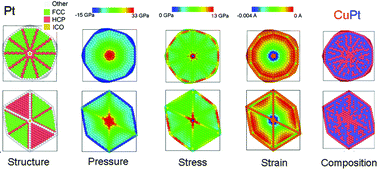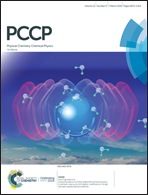Intrinsic strain-induced segregation in multiply twinned Cu–Pt icosahedra
Abstract
We present an atomistic simulation study on the compositional arrangements throughout Cu–Pt icosahedra, with a specific focus on the effects of inherent strain on general segregation trends. The coexistence of radial and site-selective segregation patterns is found in bimetallic nanoparticles for a broad range of sizes and compositions, consistent with prior analytical and atomistic models. Through a thorough comparison between the composition patterns and strain-related patterns, it is suggested that the presence of gradient and site-selective segregation is natural to largely relieve the inherent strain by preferential segregation of big atoms at tensile sites and vice versa, as previously hypothesized in the literature. Analogous to the case of single crystal particles, Cu-rich surface and damped oscillations can also be found in the outer shells of icosahedra, which are dominated by the lowering of both the surface energy and the chemical energy. The thermodynamic stability of segregated icosahedra is similar to segregated cuboctahedra but higher than disordered bulk alloys, validating prior thinking that element segregation driven by strain relief can extend the stability range of multiply-twinned nanoparticles. Our work sheds new light on understanding strain-induced segregation in multiply-twinned nanosystems that have elements with large lattice mismatch and strong alloying ability.

- This article is part of the themed collection: 2019 PCCP HOT Articles


 Please wait while we load your content...
Please wait while we load your content...